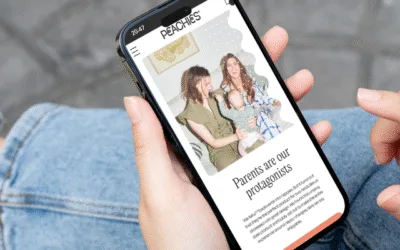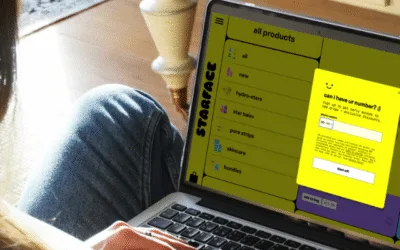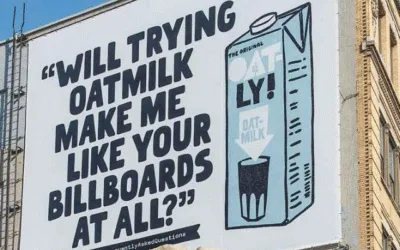Peachies beat Pampers by selling sleep, not nappies. Learn their Ladder of Why messaging trick to make your copy resonate.
If your copy feels off but you can’t quite put your finger on why… read this.
Did you know that when something is easy to read, we perceive it as more credible and appealing, even if it has the same message and the same info?

Get pro copy tips, branding tricks and e-comm insights directly to your inbox every Tuesday.
Have you ever written a piece of copy where it’s technically ticking all of the boxes but the end result still feels a bit meh?
We call those bits of copy: guilty feet.
Why? Because…

So this week, we thought we’d dig into one of the things that can turn your guilty feet copy into really great copy: nailing down the rhythm and flow.
Let’s do it 👇️
💡 This week’s big idea:
Did you know that when something is easy to read, we perceive it as more credible and appealing, even if it has the same message and the same information? This is called cognitive fluency.
And it’s one of the reasons why copy that flows naturally will have us reaching for our wallets and hitting that buy now button so much more than copy that’s a bit clunky and mechanical.
Have you ever seen some copy on a website or an ad on a train where the copy just feels like it has a life of its own?
Where it almost feels like you’re pulled into the words rather than consciously reading it?
This Jack Daniels ad from the tube is a great example of that feeling 👇
On the flip side, have you ever written a first draft where it’s ticking all of the boxes but still feels a bit meh?
You’ve nailed your brand voice, you’re hitting those pain points, you’ve made sure you’re grabbing eyeballs with your messaging…
But something about it just feels off.
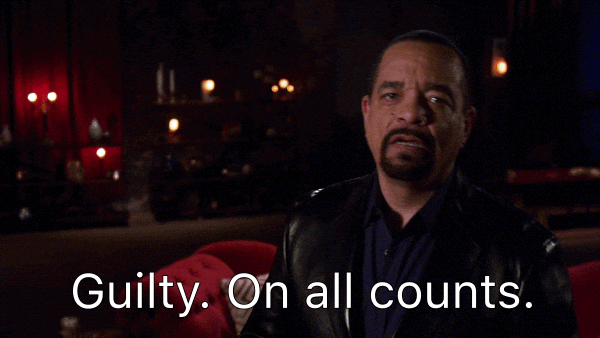
When that’s the case, the culprit is almost always the rhythm and flow of the copy.
You see, we can all get so laser-focused on the mechanics of copywriting — the pain points, the headline formulas, the consumer psychology, the brand voice — that we forget that our first goal is to make sure our copy actually gets read.
The science of why flow and rhythm matter
Your brain bloody loves rhythm.
If we asked you to recite a quote from your favourite childhood book, it’d probably take you a minute right?
But if we asked you to tell us a nursery rhyme, you could do it in your sleep.
That’s because we’re naturally drawn to patterns and rhythms. They stick in our brains.
And when copy doesn’t have a natural rhythm — or the rhythm is dull and monotone — it does the opposite. We glaze over and switch off.
It’s like Gary Provost says in this amazing quote 👇️
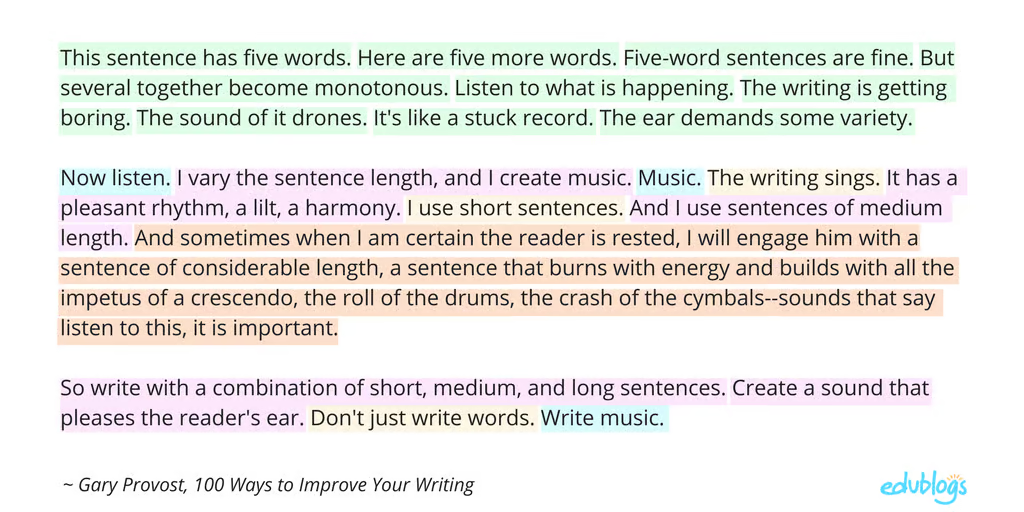
👉️ It’s not just that copy with a rhythm is stickier. Studies show that rhythmic patterns activate neural pathways linked to pleasure, memory, and persuasion. In other words, words that flow make us feel good, make us remember better and are more likely to win us over.
👉️ There’s also something called cognitive fluency, which is the idea that when something is easy to process, we perceive it as more credible and appealing. Again, making it more likely that we’ll reach for our wallets and hit that buy now button.
👉️ And, last of all, clunky copy takes us out of System 1 thinking — that flow state where we make quick decisions to buy stuff — and puts us into System 2 thinking, AKA, the analytical, “I’ll go away and think about it” mode of thinking.In other words: good rhythm and flow = good vibes = more sales.
Turn flat copy into 🔥 copy by focusing on rhythm
Rhythm is one of those things that’s half technique and half instinct.
And because of that, some people think that the ability to write copy that flows and has a natural rhythm is for the Chosen
Few. Like it’s some sacred ability reserved for the people who were born to write.
Nope. Not at all.
Sure, some people definitely have more of an ear for the music of writing than others, writing copy that flows is sometimes as simple as just applying a few linguistic tricks.
In other words, if your ear for flow isn’t quite dialed in yet, you can fake it until you make it. (Or just fake it forever.)
Let’s break it down together with a dummy copy exercise👇️
The brief:
your brand, Fika Coffee, needs a new headline and intro paragraph for your new decaf coffee blend.
You want to emphasise the following:
👉️ It has big, bold flavours and a smooth body
👉️ It can be enjoyed all day
👉️ We want to speak directly to coffee lovers
Now, diving into your first draft, you might end up with something like this…
Emphasising the boldness and the flavours? ✅
Shouting about the decafiness? ✅
Calling out that it’s roasted for coffee lovers? ✅
And yet, it still feels a bit… off?
Sure, it’s ticking all the boxes. But it feels very mechanical. It’s missing a certain spark or pep in its step.
But with a few tweaks and a dip into the toolbox of linguistic techniques, we can end up with something like this 👇️
With literally 2 minutes of editing, we’ve got something that immediately flows better. That’s easier (and more fun to read).
And is ultimately more convincing and likely to convert.
Let’s break down how we did it 👇️
Step 1: rewriting the headline
We’ve taken a few tricks and rolled them together into one headline here:
(Quick aside: these techniques are sometimes what separates an agency-level headline from a DIY headline. And they’re super simple to do.)
👉️ Added some parallelism → repeat certain sections of a phrase to create a natural rhythm. X of the Y, X of the Y.
👉️ Used some antithesis → play two contrasting ideas off against each other for impact and memorability. All of the, none of the…
👉️ Aimed for a trochaic rhythm → write your headlines so the customer naturally reads the headline like ba-da-da-ba-da, ba-da-ba-da. That sense of musicality and rhythm make it stickier and easier to read.
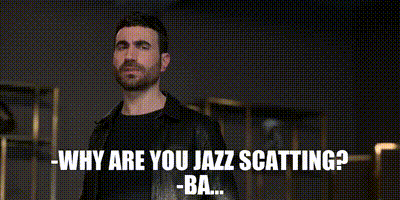
👉️ Removed all of the verbs → this is called scesis onomaton, which literally means “a stopping of words” in Greek. It’s a super easy way of making your headlines feel more immediate, impactful, and absolute by stripping them down to their core elements.
🧠 Key takeaway: remove some of the pressure on your headlines to do ALL OF THE THINGS and make sure you’re focusing on making them easy and enjoyable to read.
Here’s another headline formula you can use that has natural rhythm👇️
No/not [common misconception]. No/not [another assumption]. Just [simple truth].
For example: No junk. No sugar. Just fuel.
When to use it: in headlines where you’re overcoming objections about your products or misconceptions about your industry, OR if you’re trying to stand out from the competition.
Why it works: for starters, you have the Rule of Three going on and our brains love things in threes. (Think snap, crackle and pop, incy wincy spider, Just Do It…) We’ve also got some parallelism and antithesis going on too.
On top of that, you’re creating a sense of tension in the sentence by avoiding saying what you are for two-thirds of the headline. And because we’re hardwired to seek closure, our brains hate open loops and we feel like we have to keep reading.
So when we get to close that loop by reading the last line, we get a satisfying little click in our brains.
Step 2: adjusting the sub-copy
Again, the sub-copy below the headline in our first draft isn’t bad. It’s just functional as hell. It’s getting the right stuff in there, but it’s dry and lifeless.
So, here’s how we fixed it:
👉️ Added a more natural sentence variation → The first one was made up of lots of sentences of similar lengths. As Gary Provost told us, that creates a monotonous tone. Instead, we varied the sentence length and added some subclauses to keep the rhythm engaging and dynamic.
👉️ Dialed up the chattiness → the first version had almost no personality or sense that a person was writing it. And, unsurprisingly, we prefer reading stuff that reads like it’s been spoken to us. Using things like “So…” to start sentences or using chattier language can make a huge difference to the rhythm of your copy.
👉️ Used engaging imagery over declarative statements → We want to help the reader feel the experience rather than just reading information. So instead of “you can drink it into the day” which feels almost like we’re giving them permission, we paint a picture of “the call of the coffee machine” and “into the wee hours” to help them imagine it. And by using alliteration and slang to do this, we give the copy a bit more life and make it easier to absorb.
👉️ Mimicked the experience we’re describing → this one is a bit writerly but here we go… When you’re selling something that’s all about energy, immediate results and getting shit done, you want to keep your sentences punchy to mimic the end result you’re selling.
But when you’re writing about something that is to be savored, you want longer sentences that gently build to a conclusion rather than rush to the finish line. This is called mimetic rhythm, where the way we write matches up with what we’re writing about.
And that’s why we started with a punchy headline (to mimic the bold flavours) but ended with a longer sentence (to mimic the chill, relaxed energy you end your day with).
(Imagine if we’d ended the sub-copy with something like “Drink it all the way up to bed. Knock out. Bosh”, it would feel weird and out of place, right?)
TLDR: Write your first draft with messaging in mind, edit it with rhythm and flow in mind
There’s a lot of fancy-sounding terms in this email and although they’re all useful to know, they’re not vital to remember. (We won’t be testing you, promise.)
Instead, just focus on making sure your second draft process flows naturally. Read it out loud. See if you can read it twice as fast without tripping over the words or losing the meaning. Ask ChatGPT to check the balance of the syllables…
Keep refining it until it has that natural bounce and pep in its step.
Your audience will feel the difference, even if that can’t put their finger on why.
And ultimately, copy that’s easier and more enjoyable to read gets more customers reading it which gets more people buying.
(Oh! And copywriting that reads like it’s been written by a pro builds trust in your brand. Win win.)
Dive into more free tips and tricks 👇
How Starface use orthography to build a killer brand voice their customers love
The words you write matter. But so do your full stops, emojis and lowercase letters. Learn how to turn punctuation into a powerful part of your brand voice.
Why Oatly’s brand voice is so damn good (and how yours can be, too)
We dig into the three layers of brand voice (10,000ft, 1,000ft, ground level), show how Oatly nails each one and how you can do it for your own brand.
The weekly newsletter that takes your brand’s copy from “meh” to “hell f*cking yeah!”
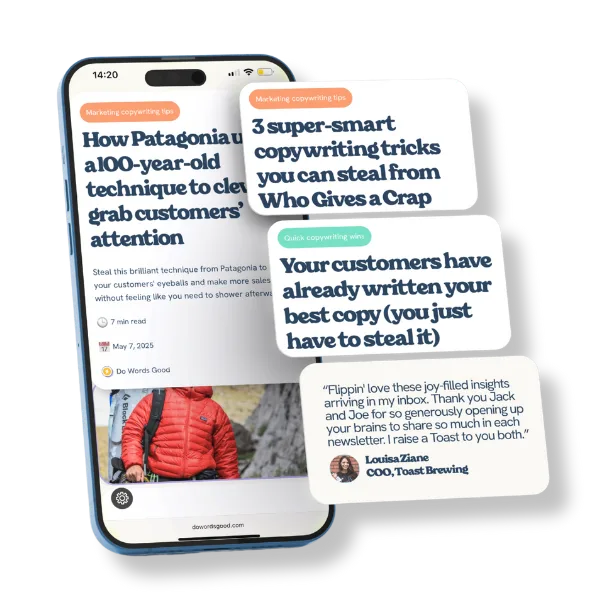
Read every week by legends at brands like these











